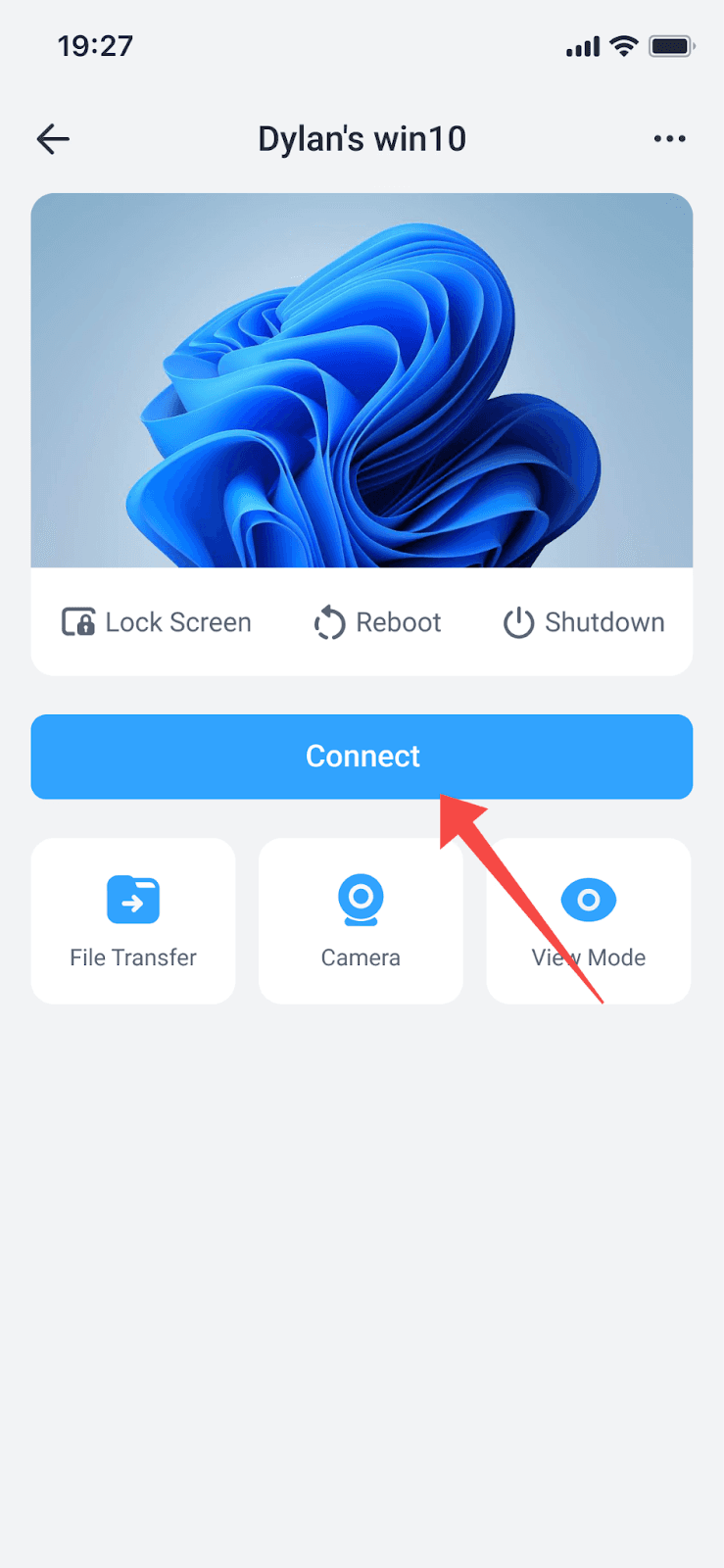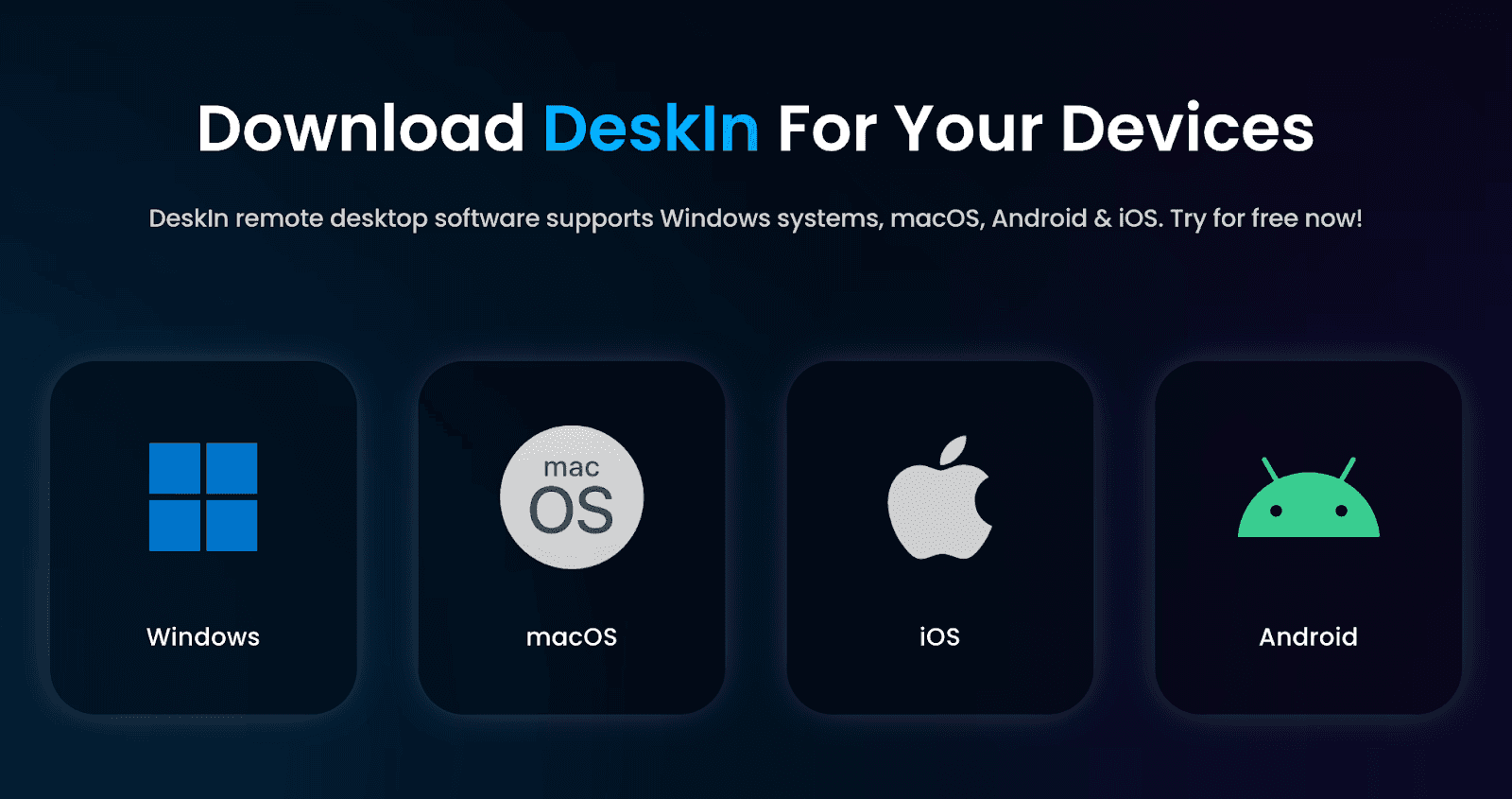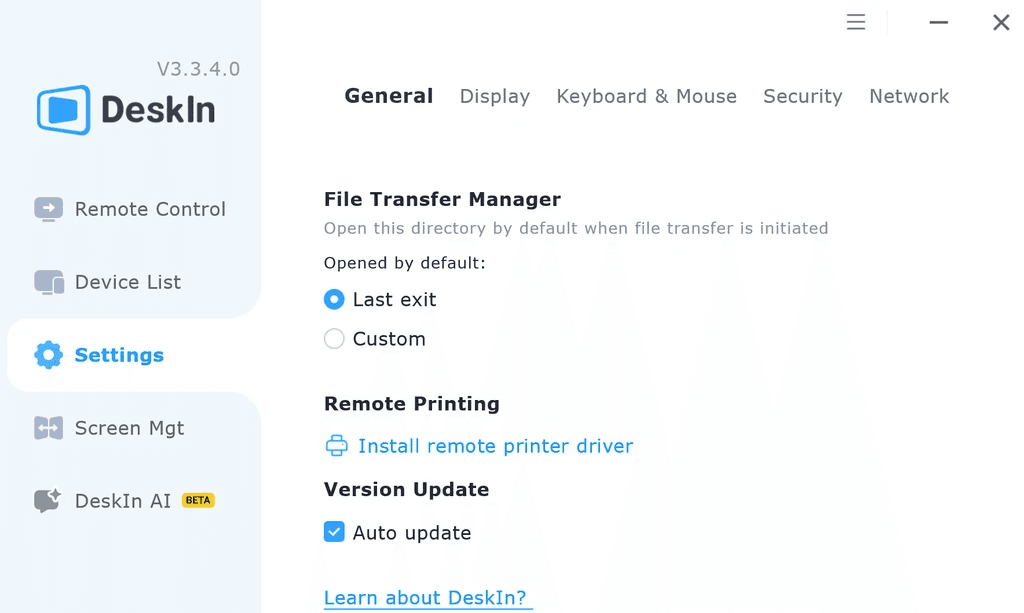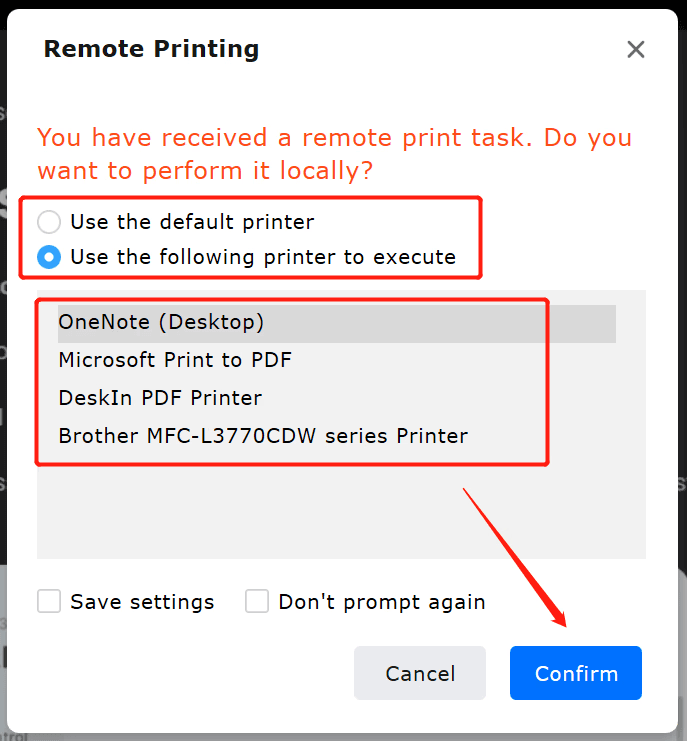DeskIn provides outstandingly stable and fast remote connection service. The secret is its self-developed real-time messaging technology framework RTC.
What is RTC?
RTC (Real-Time Communication) is a set of real-time audio and video technology framework designed specifically for large-scale, low-latency, peer-to-peer usage scenarios, especially remote desktop services.
It originates from real-time HD live streaming, using the highly efficient RTP transmission protocol and using RTT sampling, Kalmen-Filter, Jitter Buffer, and HARQ algorithms to mitigate network fluctuations and ensure fast, stable, and accurate data delivery
RTC versus Traditional remote protocol
Traditional remote software usually uses TCP protocol or UDP protocol, while DeskIn's RTC uses RTP as the transmission protocol, which is reliable without sacrificing speed.

TCP protocol sacrifices speed for reliability. To ensure high reliability, TCP relies on a three-way handshake——synchronization, synchronization acknowledgment, and final acknowledgment. The receiver needs to send a confirmation signal when receiving the data packet. Only after receiving this signal, the sender can send subsequent messages, which is the biggest reason why UDP usually causes high delays.
UDP prioritizes speed and efficiency but not guaranteed. UDP's data packet format is simpler, smaller in size, and faster in transmission speed. It is the mainstream protocol for traditional remote software. However, it lacks a verification mechanism and is susceptible to packet loss and disorder due to network fluctuations.
The RTP protocol supplements sequence information, load description, and quality monitoring on the basis of UDP. The receiving end can eliminate disorder based on the sequence information and can regularly feedback the transmission quality to the sending end. The data transfer capabilities of RTP are extended by a control protocol (RTCP). During a poor network, bandwidth overload, signal interference, packet loss may occur. The function of RTCP is to monitor and feedback the current network quality status; determine the source of RTP users to achieve Audio and video synchronization; control RTCP transmission interval and transmit minimum process control message
DeskIn RTC Technology
RTC is a software protocol that provides real-time guarantees. The difficulty lies in dynamic adjustment. The DeskIn team has more than ten years of experience in network optimization and live stream support and perfectly applies RTC to remote connections.
DeskIn not only fully integrates the standard RTC protocol, but also adds several key features, such as bandwidth estimation and forward error correction (FEC), to optimize its effectiveness. As a result, it enables DeskIn to better against latency, packet loss, and jitter.
1. Bandwidth prediction and congestion control
DeskIn RTC uses both Delay-based and Loss-based strategies to accurately measure the available bandwidth on the line.
Delay-based: Monitor delay by RTT sampling and Kalman-Filter and predict network load changes based on delay changes.
Loss-based: Intelligent identification of random packet loss, congestion packet loss and burst packet loss to prevent the line from being misclassified as congestion due to random packet loss.
After predicting the real-time available bandwidth, DeskIn RTC then uses a congestion control algorithm, increasing the comprehensive bandwidth utilization by 30% to 50% and reducing the congestion rate by 90%.
2. Eliminating network fluctuations
30% of users will encounter jitter, packet loss and other weak network conditions when they in the access line. Without weak network countermeasures, these fluctuations will cause delays and lag, which will seriously affect the operating experience.
-Jitter Buffer: Adaptive Cache Anti-Jitter
After receiving the data, the master needs to perform cache tidy-up: handling packet loss, jitter and delay. But caching brings additional delay. Traditional remote control often uses a fixed cache, and even if there are no network fluctuations, you still have to wait for tens of milliseconds.
DeskIn RTC uses adaptive Jitter caching baesd on Kalman-Filter, which automatically evaluates network latency and weaknesses, followed by dynamically adjust the length of the buffer delay to reduce the cache delay to 9~20ms, which can reduce unnecessary cache time.
-HARQ algorithm: double insurance against packet loss
To further reduce the impact of packet loss, DeskIn RTC uses the HARQ algorithm that combines automatic retransmission request (ARQ) and forward error correction coding (FEC). Even when encountering a packet loss rate of 30% it is possible to reduce the actual decoding packet loss rate to less than 3‰ through packet loss countermeasures.
To enhance reliability and reduce bandwidth consumption, DeskIn uses Reed-Solomon encoding to interleave information, allowing a redundant packet to carry information from multiple packets. After the master finds that a packet is lost, it can recover the lost data from the corresponding redundant packet.
Start a stable remote connection with DeskIn
Step 1: Install DeskIn on your computer or mobile devices, register a free account and log in.
Note: If this is your first time logging in on a new device, you need to go to your registration email to complete verification to better protect your account security.

Step 2: Enter the ID of the controlled device on the master device, click Connect, enter password or do manual verification to access.

Conclusion
With more than ten years of experience in network optimization, DeskIn committed to providing a stable and low-latency remote access experience. If you are looking for a stable remote desktop software with low latency, DeskIn would be an ideal choice.
DeskIn provides outstandingly stable and fast remote connection service. The secret is its self-developed real-time messaging technology framework RTC.
What is RTC?
RTC (Real-Time Communication) is a set of real-time audio and video technology framework designed specifically for large-scale, low-latency, peer-to-peer usage scenarios, especially remote desktop services.
It originates from real-time HD live streaming, using the highly efficient RTP transmission protocol and using RTT sampling, Kalmen-Filter, Jitter Buffer, and HARQ algorithms to mitigate network fluctuations and ensure fast, stable, and accurate data delivery
RTC versus Traditional remote protocol
Traditional remote software usually uses TCP protocol or UDP protocol, while DeskIn's RTC uses RTP as the transmission protocol, which is reliable without sacrificing speed.

TCP protocol sacrifices speed for reliability. To ensure high reliability, TCP relies on a three-way handshake——synchronization, synchronization acknowledgment, and final acknowledgment. The receiver needs to send a confirmation signal when receiving the data packet. Only after receiving this signal, the sender can send subsequent messages, which is the biggest reason why UDP usually causes high delays.
UDP prioritizes speed and efficiency but not guaranteed. UDP's data packet format is simpler, smaller in size, and faster in transmission speed. It is the mainstream protocol for traditional remote software. However, it lacks a verification mechanism and is susceptible to packet loss and disorder due to network fluctuations.
The RTP protocol supplements sequence information, load description, and quality monitoring on the basis of UDP. The receiving end can eliminate disorder based on the sequence information and can regularly feedback the transmission quality to the sending end. The data transfer capabilities of RTP are extended by a control protocol (RTCP). During a poor network, bandwidth overload, signal interference, packet loss may occur. The function of RTCP is to monitor and feedback the current network quality status; determine the source of RTP users to achieve Audio and video synchronization; control RTCP transmission interval and transmit minimum process control message
DeskIn RTC Technology
RTC is a software protocol that provides real-time guarantees. The difficulty lies in dynamic adjustment. The DeskIn team has more than ten years of experience in network optimization and live stream support and perfectly applies RTC to remote connections.
DeskIn not only fully integrates the standard RTC protocol, but also adds several key features, such as bandwidth estimation and forward error correction (FEC), to optimize its effectiveness. As a result, it enables DeskIn to better against latency, packet loss, and jitter.
1. Bandwidth prediction and congestion control
DeskIn RTC uses both Delay-based and Loss-based strategies to accurately measure the available bandwidth on the line.
Delay-based: Monitor delay by RTT sampling and Kalman-Filter and predict network load changes based on delay changes.
Loss-based: Intelligent identification of random packet loss, congestion packet loss and burst packet loss to prevent the line from being misclassified as congestion due to random packet loss.
After predicting the real-time available bandwidth, DeskIn RTC then uses a congestion control algorithm, increasing the comprehensive bandwidth utilization by 30% to 50% and reducing the congestion rate by 90%.
2. Eliminating network fluctuations
30% of users will encounter jitter, packet loss and other weak network conditions when they in the access line. Without weak network countermeasures, these fluctuations will cause delays and lag, which will seriously affect the operating experience.
-Jitter Buffer: Adaptive Cache Anti-Jitter
After receiving the data, the master needs to perform cache tidy-up: handling packet loss, jitter and delay. But caching brings additional delay. Traditional remote control often uses a fixed cache, and even if there are no network fluctuations, you still have to wait for tens of milliseconds.
DeskIn RTC uses adaptive Jitter caching baesd on Kalman-Filter, which automatically evaluates network latency and weaknesses, followed by dynamically adjust the length of the buffer delay to reduce the cache delay to 9~20ms, which can reduce unnecessary cache time.
-HARQ algorithm: double insurance against packet loss
To further reduce the impact of packet loss, DeskIn RTC uses the HARQ algorithm that combines automatic retransmission request (ARQ) and forward error correction coding (FEC). Even when encountering a packet loss rate of 30% it is possible to reduce the actual decoding packet loss rate to less than 3‰ through packet loss countermeasures.
To enhance reliability and reduce bandwidth consumption, DeskIn uses Reed-Solomon encoding to interleave information, allowing a redundant packet to carry information from multiple packets. After the master finds that a packet is lost, it can recover the lost data from the corresponding redundant packet.
Start a stable remote connection with DeskIn
Step 1: Install DeskIn on your computer or mobile devices, register a free account and log in.
Note: If this is your first time logging in on a new device, you need to go to your registration email to complete verification to better protect your account security.

Step 2: Enter the ID of the controlled device on the master device, click Connect, enter password or do manual verification to access.

Conclusion
With more than ten years of experience in network optimization, DeskIn committed to providing a stable and low-latency remote access experience. If you are looking for a stable remote desktop software with low latency, DeskIn would be an ideal choice.

Play x Work
All at Once
DeskIn Remote Game
only $14.32 USD 🎉 Limited on July 16-31
Add promo code: deskinsummer1



















